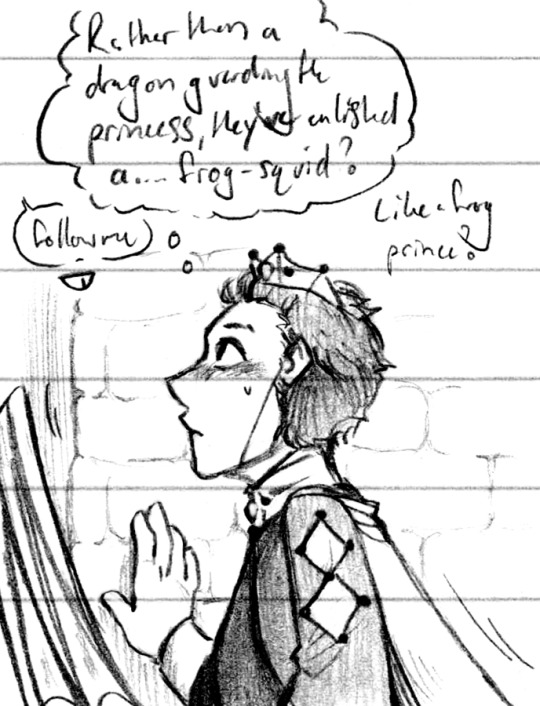#More than just interpretation through body language or touching when in close proximity - more nuanced vibrations maybe? :0
Photo







Can’t deny, that is definitely a Princess (P1 | P2 | P3) (Patreon)
#Doodles#SCII#The Captain#DAX#ZEX#Obviously ZEX had to be the Princess! Come on now! Lol#Why was DAX so ready to let the Captain in? Wouldn't that just encourage ZEX? I mean first of all what else is ZEX up to lol#Very Snow White/Rapunzel banished/exiled/captured princess vibes haha#Poor ZEX he'd love to go out but he's in royal time out! You'd think there'd be more monitoring on Princes coming to rescue him hehe#Anyway point is most Princes back out of rescuing him for some reason hm ♪ DAX is just letting it play out haha#The Captain's reactions are encouraging! And then DAX can get back to his peace and quite haha#I do love the one of DAX pressing his head tendrils against the door as he speaks haha - do you suppose they have a kind of hearing to them?#I mean I still think those little pockets on the sides of their heads are VUX ears but I wonder if their tendrils could aid in hearing?#More than just interpretation through body language or touching when in close proximity - more nuanced vibrations maybe? :0#And even if not all that then just like resting fingertips on the outside of the door while speaking through it hehe <3 It's cute!#Designing ZEX's dress was fun hehe ♪ I went through a couple versions and I'm glad this is the one I settled on :D#Initially the skirt was plain - I'm still not Fully sold on it but I do like the idea of it mimicking those little red marks on VUX forehead#And of course he needs a pretty tiara/tendril jewelry! He has to be the prettiest in case of company!#For some reason the Captain is having second thoughts haha
20 notes
·
View notes
Text
“Different Channels of Non-verbal Communication Across Cultures”
Non-verbal communications is basically sending and receiving messages in a variety of ways without the use of verbal codes (words). It is both intentional and unintentional. (Dr Charles Tidwell, Dean Emeritus, Andrews University). These could be through gestures touch, glance, eye contact (gaze), volume, vocal nuance, proximity, facial expression, pause (silence), intonation, dress, posture, smell, word choice and syntax, sounds (paralanguage). Intentional, maybe because there is a need to use it or maybe it is in the proper setting to use it, while, unintentional, because perception varies across people and of course Culture.
The way we move our body gives meaning, and these meanings differ from one culture to another, this movement of body is called Kinesics which have basically five different types; emblems, regulators, illustrators, affective display and adaptors. The “ok” sign made by forming a circle with your thumb and forefinger and streching out the rest of the three fingers can mean “zero” or literally number “3” for other countries but for country like Australia, it is very obscene as The "V" sign (made with index and middle fingers, palm facing inward) is a very vulgar gesture. The "thumbs up" gesture is also considered obscene. (e-Diplomat, 2017). On the other hand, the ring gesture In Tunisia means " I’ll kill you! ". These are emblematic gestures.
Regulators can be explained in the example: the white american students may use sounds such as “uh-huh” followed by nodding of the head to indicate understanding. However, the black american students use silence to show understanding. Therefore, it may lead to confusion for the white americans as to whether the black students understand what is being said. Illustrators like pointing, that adds to the verbal messages, vary also. In “Pointing”, US uses index finger, Germany with little finger, Japanese with entire hand (Dr Charles Tidwell, Dean Emeritus, Andrews University). Countries also interpret differently in Expressions of love, frustration, or anger. (affective display) and Shifting body and/or feet position when seated (adaptors).
Most of the time, we used are face and indeed, it helps the conversation intact. The reason why many people prefer face-to-face communication rather than digital or technologically mediated is that, facial expressions add meanings and emotions to messages verbally transmitted. In other countries, men are expected to control their emotions while women are expected to express their emotions more freely. A study found that the Chinese participants relied on the eyes more to represent facial expressions, while Western Caucasians relied on the eyebrows and mouth. (American Psychological Association, 2011). Other countries, too much smiling is viewed in as a sign of shallowness.
When we talk to a person, there is certain space between the two persons talking. Other countries give meaning to that. However, these so-called personal space may not only fall under the relationship matter whether he or she has an intimate relationship with you, but also with the setting and condition. For example, an ill-person , whose sickness is contagious cannot talk to someone close or maybe two friends talking in a crowded train. Example, Americans trying to keep the normal distance between themselves and their partners might seem “stand-offish”; while the Arabs tending to keep a much closer distance might seem a bit “pushy”. (China Teaching Website)
In most cases, color and objects define the personality of an individual. What other people wear, whether a dress or a piece of jewelry, this mean something. For example, Red has been traditionally one of the favourite colours in Chinese culture because the color represents happiness and wealth. (Liisa Salo-Lee, 2006)
In western cultures touching (haptics) is infrequent which makes it even more significant when it happens. French and Italians for example, tend to touch frequently even continuously while walking, whereas the British prefer not to touch at all. (Chris, 2013 “The Only Book On Body Language That Everybody Needs To Read”)
Time perception (chronemics) differs in various cultures, which can create misunderstandings if a person is unaware of the cultural differences.For example, in America time flies. People are pressured and constrained by time because they are trying to control it. In the business world, Americans are expected to arrive to meetings on time, and usually, even early. On the other hand, they arrive late to parties and dances.
Differences in the use of silence can lead to negative stereotyping. The Athabaskan Indians of North America do not engage in small talk with strangers, whereas European and African Americans use small talk to establish relationships. (Menzies, 2016)
As a Filipino, I noticed a lot of Non-verbal communications we, Filipinos, used. The “Mano po” which is showing respect to the elders, the sign of the cross when entering a catholic church or passing by the church, the way of non-verbal calling with a hand upside down, the honest smile of Filipinos even in the midst of catastrophe, our so-called “Filipino-time”, being late from the actual time, the personal closeness of couple when going to malls or parks and the like. Everyone should understand and value the importance of cultural differences because in that way we can respect each other’s beliefs, customs and traditions. There are lots of ways we can understand and be understood, it is just a matter of discovering and observing.
References:
· American Psychological Association APA, 2011 “Perception of Facial Expressions Differs Across Cultures
http://www.apa.org/news/press/releases/2011/09/facial-expressions.aspx
· Dr Charles Tidwell, Dean Emeritus, Andrews University, “Non-Verbal Commuication Modes”
https://www.andrews.edu/~tidwell/bsad560/NonVerbal.html
· Chris, 2013, “The Only Book On Body Language That Everybody Needs To Read” http://bodylanguageproject.com/the-only-book-on-body-language-that-everybody-needs-to-read/author/admin2/
· E- Dimplomat, March 6, 2017 “Australia”
http://www.ediplomat.com/np/cultural_etiquette/ce_au.htm
· Elizabeth Kuhnke , 2011 “Kinesics: The Categories of Gesture”
https://elizabethkuhnke.wordpress.com/2011/05/10/kinesics-the-categories-of-gesture/
· Geert Hofstede International Information , “Non-verbal Communication within the Culture” http://www.chinateachingnet.com/non-verbal.shtml
· Felicity Menzies, Principal , Culture Plus Consulting, “Cultural Intelligence & Paralanguage: Using Your Voice Differently Across Cultures”
https://cultureplusconsulting.com/2015/04/16/cultural-intelligence-paralanguage-using-your-voice-differently-across-cultures/
0 notes